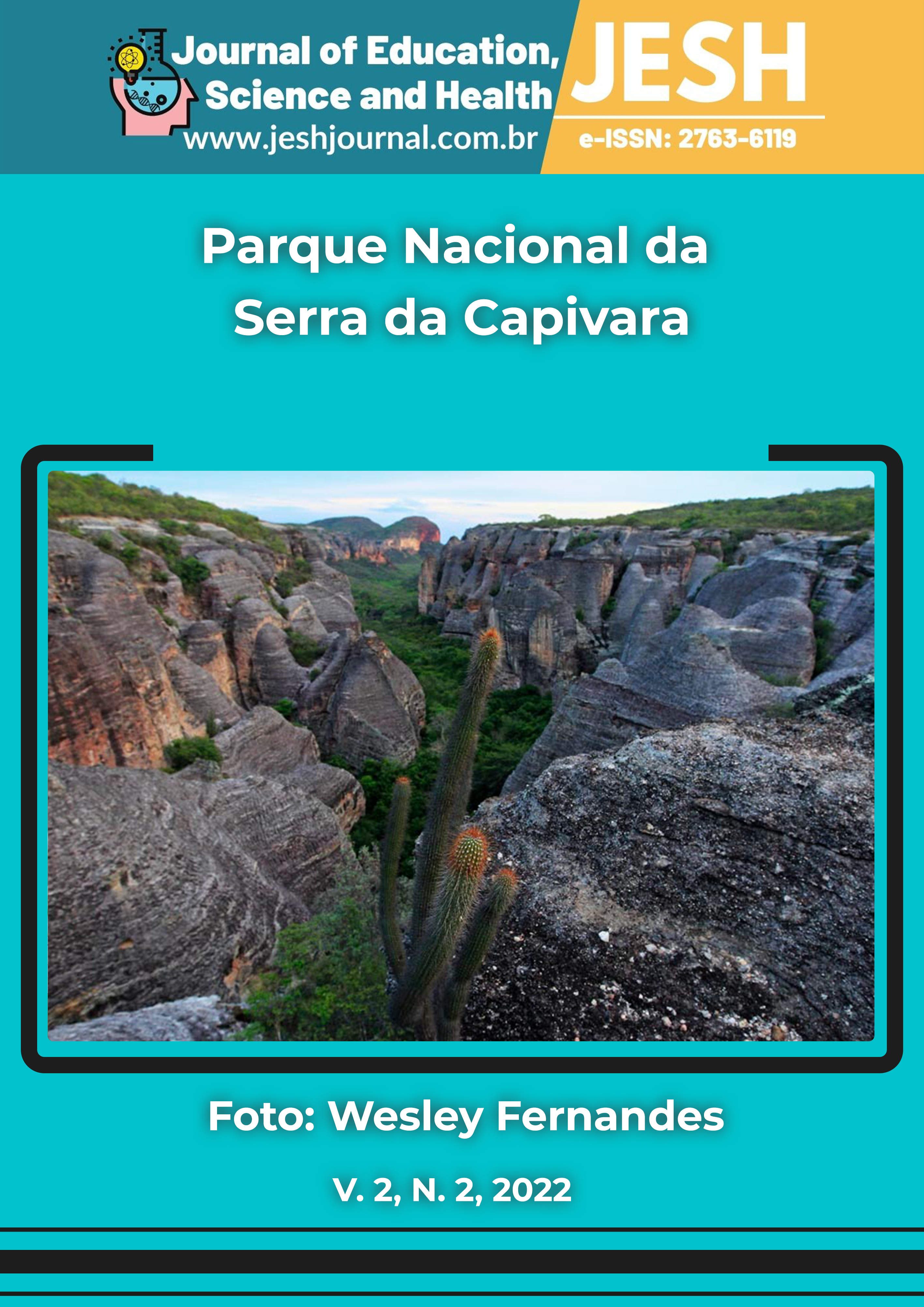The Prone Position and its benefits in the treatment of Acute Respiratory Distress Syndrome: an integrative review
Prone position and its benefits in the treatment of acute Respiratory Distress Syndrome: an integrative review
DOI:
10.52832/jesh.v2i2.104Keywords:
Adult respiratory distress syndrome, Prone position, PhysiotherapyAbstract
Due to the high mortality, alternative therapeutic strategies have been adopted in clinical practice for acute respiratory distress syndrome (ARDS), such as the prone position, which, with the patient in the prone position, relieves atelectasis and improves oxygenation and perfusion. Objective: To verify, in the literature, evidence that proves the benefits of using the prone position in patients with acute respiratory distress syndrome (ARDS). Method. Integrative literature review. Search in databases: BVS, SciELO, Lilacs, PubMed and Academic Google, using the Descriptors in Health Sciences (DeCS): Adult Respiratory Distress Syndrome; prone position; Mechanical ventilation; Non-invasive ventilation; Physiotherapy, crossed by the Boolean operator AND. After applying the eligibility criteria and evaluation by titles, abstracts and full reading, 13 studies were selected for the preparation of this review. Results and discussion. The prone position (PP) is essential to reduce the extent and mortality of ARDS. In addition to preventing orotracheal intubation, PP promotes an improvement in the PaO2/FiO2 ratio, an increase in O2 saturation, an improvement in lung compliance, a reduction in ICU bed occupancy and time to hospital discharge. PP is a highly efficient, low-cost technique with several benefits to the respiratory mechanics of patients.
Downloads
Metrics
References
Ananias, M. A. N. B., Cambraia, A. A., & Calderaro, D. C. (2017). Effect of prone position on respiratory mechanics and gas exchanges in patients with severe ARDS. Revista Médica de Minas Gerais, 28(Supl 5), e-S280528. https://doi.org/10.34119/bjhrv3n5-336 DOI: https://doi.org/10.5935/2238-3182.20180140
Araújo, M. S. D., Santos, M. M. P. D., Silva, C. J. A., Menezes, R. M. P., Feijão, A. R., & Medeiros, S. M. (2021). Posição prona como ferramenta emergente na assistência ao paciente acometido por COVID-19: scoping review. Revista Latino-Americana de Enfermagem, 29, e3397. https://doi.org/10.1590/1518-8345.4732.3397 DOI: https://doi.org/10.1590/1518-8345.4732.3397
Bellani, G., Laffey, J. G., Pham, T., Fan, E., Brochard, L., Esteban, A., Gattinoni, L., van Haren, F., Larsson, A., McAuley, D. F., Ranieri, M., Rubenfeld, G., Thompson, B. T., Wrigge, H., Slutsky, A. S., Pesenti, A.; LUNG SAFE Investigators; & ESICM Trials Group. (2016). Epidemiology, patterns of care, and mortality for patients with acute respiratory distress syndrome in intensive care units in 50 countries. Jama, 315(8), 788-800. https://doi.org/10.1001/jama.2016.0291 DOI: https://doi.org/10.1001/jama.2016.0291
Chad, T., & Sampson, C. (2020). Prone positioning in conscious patients on medical wards: A review of the evidence and its relevance to patients with COVID-19 infection. Clinical Medicine, 20(4), e97. https://dx.doi.org/10.7861/clinmed.2020-0179 DOI: https://doi.org/10.7861/clinmed.2020-0179
Clarke, J., Geoghegan, P., McEvoy, N., Boylan, M., Ní Choileáin, O., Mulligan, M., Hogan, G., Keogh, A., McElvaney, O. J., McElvaney, O. F., Bourke, J., McNicholas, B., Laffey, J. G., McElvaney, N. G., & Curley, G. F. (2021). Prone positioning improves oxygenation and lung recruitment in patients with SARS-CoV-2 acute respiratory distress syndrome; a single centre cohort study of 20 consecutive patients. BMC Research Notes, 14(1), 1-6. https://doi.org/10.1186/s13104-020-05426-2 DOI: https://doi.org/10.1186/s13104-020-05426-2
Cordeiro, J., Rotta, K., Bressanim, E., Porto, I., & Rauber, R. (2020). Posição Prona como Manobra Terapêutica para Tratamento da Síndrome da Angústia Respiratória Aguda em Gestante: Um Relato de Caso. Fag Journal of Health (FJH), 2(2), 329-333. https://doi.org/10.35984/fjh.v2i2.196 DOI: https://doi.org/10.35984/fjh.v2i2.196
Cutts, S., Talboys, R., Paspula, C., Prempeh, E. M., Fanous, R., & Ail, D. (2017). Adult respiratory distress syndrome. Annals of the Royal College of Surgeons of England, 99(1), 12–16. https://doi.org/10.1308/rcsann.2016.0238 DOI: https://doi.org/10.1308/rcsann.2016.0238
Dalmedico, M. M., Salas, D., Oliveira, A. M. de., Baran, F. D. P., Meardi, J. T., & Santos, M. C. (2017). Efetividade da posição prona na síndrome do desconforto respiratório agudo: overview de revisões sistemáticas. Revista da Escola de Enfermagem da USP, 51, e03251. https://doi.org/10.1590/S1980-220X2016048803251 DOI: https://doi.org/10.1590/s1980-220x2016048803251
Damarla, M., Zaeh, S., Niedermeyer, S., Merck, S., Niranjan-Azadi, A., Broderick, B., & Punjabi, N. (2020). Prone Positioning of Nonintubated Patients with COVID-19. American journal of respiratory and critical care medicine, 202(4), 604–606. https://doi.org/10.1164/rccm.202004-1331LE DOI: https://doi.org/10.1164/rccm.202004-1331LE
Dong, W., Gong, Y., Feng, J., Bai, L., Qing, H., Zhou, P., Du, Y., Zhu, J., & Xu, S. (2020). Early awake prone and lateral position in non-intubated severe and critical patients with COVID-19 in Wuhan: A respective cohort study. medRxiv. https://doi.org/10.1101/2020.05.09.20091454 DOI: https://doi.org/10.1101/2020.05.09.20091454
Dos Anjos, J. L. M., Santos Junior, F. L., Pires, T. Q., Rocha, G. A., Moreira, P. D. F., & Durães, A. R. (2020). Posição prona em pacientes em ventilação espontânea com insuficiência respiratória por COVID-19: relato de caso. Revista Pesquisa Em Fisioterapia, 10(3), 537–542. https://doi.org/10.17267/2238-2704rpf.v10i3.3088 DOI: https://doi.org/10.17267/2238-2704rpf.v10i3.3088
Elkattawy, S., & Noori, M. (2020). A case of improved oxygenation in SARS-CoV-2 positive patient on nasal cannula undergoing prone positioning. Respiratory medicine case reports, 30, 101070. https://doi.org/10.1016/j.rmcr.2020.101070 DOI: https://doi.org/10.1016/j.rmcr.2020.101070
Guérin, C., Albert, R. K., Beitler, J., Gattinoni, L., Jaber, S., Marini, J. J., Munshi, L., Papazian, L., Pesenti, A., Vieillard-Baron, A., & Mancebo, J. (2020). Prone position in ARDS patients: why, when, how and for whom. Intensive care medicine, 46(12), 2385–2396. https://doi.org/10.1007/s00134-020-06306-w DOI: https://doi.org/10.1007/s00134-020-06306-w
Oliveira, R. P. D., Teixeira, C., & Rosa, R. G. (2020). Síndrome do desconforto respiratório agudo: como estão os pacientes após a unidade de terapia intensiva?. Revista Brasileira de Terapia Intensiva, 31, 555-560. https://doi.org/10.5935/0103-507X.20190074 DOI: https://doi.org/10.5935/0103-507X.20190074
Parry, D. C., Gaudard, A. M. I. S., & Barbosa, P. V. R. Uso da posição prona nos pacientes com Síndrome do Desconforto Respiratório do Adulto.Rev. Educ. Saúde, 8(1), 199-210. https://doi.org/10.29237/2358-9868.2020v8i1.p199-210 DOI: https://doi.org/10.29237/2358-9868.2020v8i1.p199-210
Pinheiro, N. R., & de Almeida Brito, L. G. (2020). Recrutamento alveolar associado à posição prona em pacientes com SDRA por Influenza H1N1. Revista Eletrônica Acervo Saúde, 12(12), e5151-e5151. https://doi.org/10.25248/reas.e5151.2020 DOI: https://doi.org/10.25248/reas.e5151.2020
Quadros, T. C. C., Horn, T. L., Ribas, A., Blattner, C. N., Soares, B. P, & Melo, D. A. da S. (2021). Utilização da posição prona em ventilação espontânea em paciente com COVID-19. Scientia Medica, 31(1), e39982-e39982. https://doi.org/10.15448/1980-6108.2021.1.39982 DOI: https://doi.org/10.15448/1980-6108.2021.1.39982
Raoof, S., Nava, S., Carpati, C., & Hill, N. S. (2020). High-Flow, Noninvasive Ventilation and Awake (Nonintubation) Proning in Patients With Coronavirus Disease 2019 With Respiratory Failure. Chest, 158(5), 1992–2002. https://doi.org/10.1016/j.chest.2020.07.013 DOI: https://doi.org/10.1016/j.chest.2020.07.013
Ribeiro, R. P., Ribeiro, P. H. V., Marziale, M. H. P., Martins, M. B., & Santos, M. R. D. (2011). Obesidade e estresse entre trabalhadores de diversos setores de produção: uma revisão integrativa. Acta Paulista de Enfermagem, 24(4), 577-581. https://doi.org/10.1590/S0103-21002011000400020 DOI: https://doi.org/10.1590/S0103-21002011000400020
Souza, M. T. D., Silva, M. D. D., & Carvalho, R. D. (2010). Revisão integrativa: o que é e como fazer. Einstein (São Paulo), 8, 102-106. https://doi.org/10.1590/S1679-45082010RW1134 DOI: https://doi.org/10.1590/s1679-45082010rw1134
Venus, K., Munshi, L., & Fralick, M. (2020). Prone positioning for patients with hypoxic respiratory failure related to COVID-19. CMAJ: Canadian Medical Association journal = journal de l'Association medicale canadienne, 192(47), E1532–E1537. https://doi.org/10.1503/cmaj.201201 DOI: https://doi.org/10.1503/cmaj.201201
Viana, W. N. (2015). Síndrome de angústia respiratória aguda após Berlim. Pulmäo RJ, 24(3), 31-35.
Winck, J. C., & Ambrosino, N. (2020). COVID-19 pandemic and non invasive respiratory management: every Goliath needs a David. An evidence based evaluation of problems. Pulmonology, 26(4), 213-220. https://doi.org/10.1016/j.pulmoe.2020.04.013 DOI: https://doi.org/10.1016/j.pulmoe.2020.04.013
Downloads
Published
How to Cite
Issue
Section
License
Copyright (c) 2022 Journal of Education, Science and Health – JESH

This work is licensed under a Creative Commons Attribution-NonCommercial 4.0 International License.

































